在pandas中读取 Excel 表格后,有多种方式可以按列、按行提取数据,下面我将详细介绍常见的方法。
0.声明
在本文中我使用的excel表内容如下:

1. 读取 Excel 文件
首先,我们需要使用 pandas 的 read_excel 函数读取 Excel 文件,示例代码如下:
import pandas as pd
# 读取 Excel 文件
df = pd.read_excel(excel_file_path, sheet_name)
- excel_file_path为文件路径
- sheet_name为工作表名称
2. 按列提取数据
2.1 通过列名提取单列数据
可以使用方括号 [] 并传入列名来提取单列数据,提取后的数据类型为 pandas.Series。
# 提取名为 'age' 的列
column_data = df['age']
print(column_data)
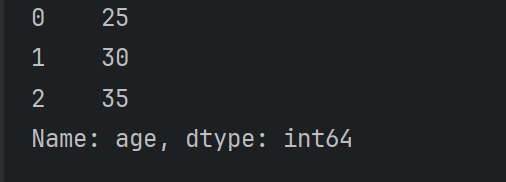
2.2 通过列名提取多列数据
若要提取多列数据,可在方括号 [] 中传入一个包含列名的列表,提取后的数据类型为 pandas.DataFrame。
# 提取 'age' 和 'name' 两列
columns_data = df[['age', 'name']]
print(columns_data)
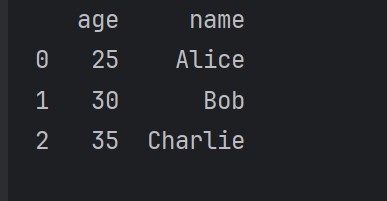
2.3 通过列索引提取单列数据
使用 iloc 方法,通过列的整数索引来提取单列数据。
# 提取第 0 列(索引从 0 开始)
first_column = df.iloc[:, 0]
print(first_column)
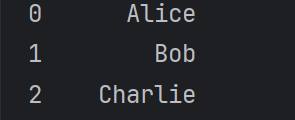
2.4 通过列索引提取多列数据
同样使用 iloc 方法,通过指定列索引范围来提取多列数据。
# 提取第 0 列到第 2 列(不包含第 2 列)
selected_columns = df.iloc[:, 0:2]
print(selected_columns)
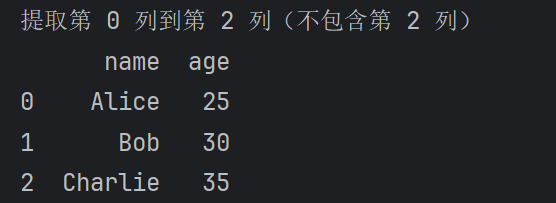
3. 按行提取数据
3.1 通过行索引提取单行数据
使用 iloc 方法,通过行的整数索引来提取单行数据,提取后的数据类型为 pandas.Series。
# 提取第 0 行(索引从 0 开始)
first_row = df.iloc[0]
print(first_row)
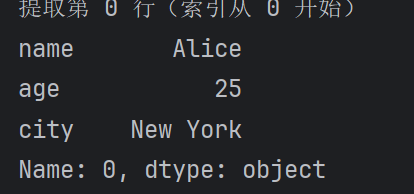
3.2 通过行索引提取多行数据
使用 iloc 方法,通过指定行索引范围来提取多行数据,提取后的数据类型为 pandas.DataFrame。
# 提取第 0 行到第 2 行(不包含第 2 行)
selected_rows = df.iloc[0:2]
print(selected_rows)

3.3 通过条件筛选提取行数据
可以根据某列的条件来筛选出符合条件的行。
#提取 'age 列中值大于 10 的行
filtered_rows = df[df['age'] > 10]
print(filtered_rows)
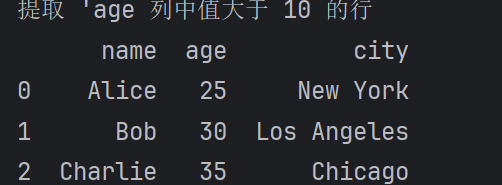
4. 按行和列同时提取数据
4.1 使用 iloc 按行和列索引提取数据
# 提取第 0 行到第 2 行(不包含第 2 行)和第 0 列到第 2 列(不包含第 2 列)的数据
subset = df.iloc[0:2, 0:2]
print(subset)
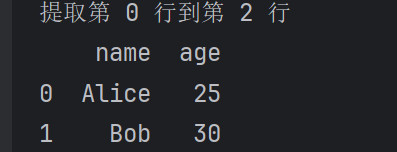
5.总代码
这是本文中所使用的代码,大家可以复制下来自己运行一遍
import pandas as pd
excel_file_path="./data.xlsx"
sheet_name="Sheet1"
# 读取 Excel 文件
df = pd.read_excel(excel_file_path, sheet_name)
# 提取名为 'age' 的列
print("提取名为 'age' 的列")
column_data = df['age']
print(column_data)
# 提取 'age' 和 'name' 两列
print("提取 'age' 和 'name' 两列")
columns_data = df[['age', 'name']]
print(columns_data)
# 提取第 0 列(索引从 0 开始)
print("提取第 0 列(索引从 0 开始)")
first_column = df.iloc[:, 0]
print(first_column)
# 提取第 0 列到第 2 列(不包含第 2 列)
print("提取第 0 列到第 2 列(不包含第 2 列)")
selected_columns = df.iloc[:, 0:2]
print(selected_columns)
# 提取第 0 行(索引从 0 开始)
print("提取第 0 行(索引从 0 开始)")
first_row = df.iloc[0]
print(first_row)
# 提取第 0 行到第 2 行(不包含第 2 行)
print("提取第 0 行到第 2 行(不包含第 2 行)")
selected_rows = df.iloc[0:2]
print(selected_rows)
# 提取 'age 列中值大于 10 的行
print("提取 'age 列中值大于 10 的行")
filtered_rows = df[df['age'] > 10]
print(filtered_rows)
# 提取第 0 行到第 2 行(不包含第 2 行)和第 0 列到第 2 列(不包含第 2 列)的数据
print("提取第 0 行到第 2 行")
subset = df.iloc[0:2, 0:2]
print(subset)
6.总结
通过学习以上代码,你会掌握excel读取数据的基本方法。在python中会将读取的excel转换为DataFrame格式。这是一个功能强大且灵活的数据结构,在数据处理、分析和可视化等领域都有广泛的应用,你可以通过阅读我的另一篇文章来了解DataFrame格式的常见用法,